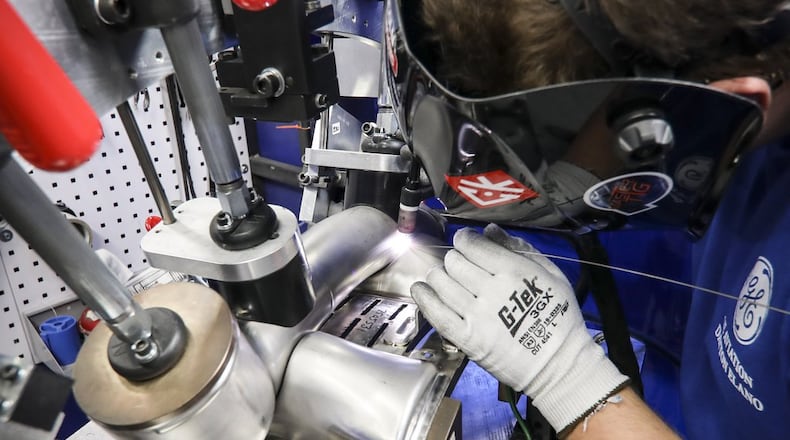“It’s what we call meritocracy,” said Tyler Reed, manager of the main Unison plant at 2455 Dayton-Xenia Road in Beavercreek. “We reward performance.”
Fueled in part by the success of GE Aviation’s LEAP jet aircraft engine, aviation technology manufacturer Unison expects to hire about 30 skilled employees this year, mostly aerospace welders.
Introduced more than a decade ago, the LEAP is touted as the fastest selling engine in aviation history, with 17,000 orders booked as of March, Reed said.
The Beavercreek plant began its life as an Elano Corp. facility before GE merged two subsidiaries — Unison and Elano — under the Unison banner in 2004. GE acquired Elano in 1986; in 2002, GE acquired Unison.
The LEAP engine is a product of West Chester Twp.-based CFM International, whose 50/50 parent companies are GE Aviation and France’s Safran Aircraft Engines.
The engine is touted as being among the first to employ advanced ceramic-matrix materials, resulting in what GE Aviation says is an efficient engine that passed 1.5 million aircraft flight hours in the summer of 2018.
Ina Petras, Unison site human resources leader, said Unison welders start at about $18 an hour and can reach about $25 base pay within five years, along with overtime and shift differentials.
Mike Thompson — a Greene County Career Center welding and fabrication instructor, with military aircraft welding experience — said he has several current students with their sights set on a career with Unison, attracted by the company’s high pay and high standards.
“I supply a lot of welders to them,” Thompson said. In fact, he has “dozens” of graduates working for the company.
The relationship between the career center and Unison has a history. Ron Bolender, spokesman for the career center, said he has held his current job for 22 years, and the relationship is at least as old as that.
The Unison weld test is seen as one of the toughest in the country, Thompson said. Welding candidates need to show proficiency at “tube to plate” and “tube to tube” welding, as well as TIG welding — “Tungsten Inert Gas” or gas tungsten arc welding.
Students need to be able to weld minutely thin alloys in precision jobs.
“It’s very thin material, and you have to pay very, very close attention to detail,” Thompson said. “It is quite exacting.”
Unison has about 800 employees total across seven facilities located within 10 square miles in Beavercreek. A Unison sales force works at The Greene, also in Beavercreek.
Reed said recent hiring is based not just on the LEAP’s success but on “NPI” projects, or new product introduction work. The manufacturer hired about 80 employees last year and projects the addition of about 30 new employees this year.
Most of those 30 new employees will be welders, the plant manager said.
The local plant produces engine manifolds, small and large complex tubes, joints and gimbals across various engine platforms – a lot of external hardware on engines.
Because the company is looking for the right people able to perform a niche skill, Unison is looking beyond the Dayton area for the right candidates.
“We look for the best of the best, and we will develop these folks into highly skilled welders,” Reed said.
But the company is more than willing to train promising candidates through an internal weld-school program. In fact, every welder goes through that program, Reed said.
Unison is not necessarily looking for years of experience.
“Whether you’re a new welder or an experienced welder, every single person will go through our weld school,” Reed said.
Smaller businesses won’t pay as well as Unison, Thompson cautioned. But the skill does open doors. Starting out in some apprenticeship programs, students can make more than $19 an hour. At smaller job shops, starting pay for welders is probably closer to $15 to $16 an hour.
“You can make a good living welding,” Thompson said.
It’s a function of supply and demand. A demanding, unique still brings a premium.
“It is so hard to find good quality employees who know the skill and can do the job well,” Thompson said.
Welders need good reading comprehension, solid hand-eye coordination, an unshakable work ethic, the willingness to put in the “helmet time” — and patience, he said.
Said Thompson: “If anyone could weld in five minutes, we wouldn’t have the demand.”
Thompson’s welding program today has 22 seniors, 22 juniors, and he expects 28 juniors coming into next year’s program.
“We do look at it not just as a job, but a career,” he said.
By the numbers
$41,380 per year: 2018 median pay for Welders, Cutters, Solderers and Brazers
22,500: Number of new jobs expected in this field, 2016-2026
$19.89 per hour: 2018 median pay for Welders, Cutters, Solderers and Brazers
6 percent: Expected job growth, 2016-2026
Source: Bureau of Labor Statistics
About the Author

